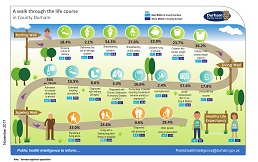Situated in the north east of the country, County Durham stretches from Peterlee and Seaham in the east, to Harwood and Killhope in the west and Burnopfield in the north to Barningham in the south. The county is bordered by Sunderland, Gateshead, Northumberland, Cumbria, North Yorkshire, Darlington, Stockton-on-Tees
and Hartlepool.
Throughout history, County Durham has been strategically important to settlers ranging from the Romans to the Angles, Saxons and Normans. Northumbria became the leading centre of the Christian church in Britain with the foundation of Durham Cathedral in 1093 acting as a lasting reminder of the County’s legacy to
Christian worship in Britain.
Following the Norman Conquests, William the Conqueror invested the Bishops of Durham with combined secular and spiritual powers to control the modern counties of Cleveland, Durham and Tyne and Wear. The Prince Bishops levied taxes, raised armies, minted money, controlled the courts and were effectively ‘kings’ of North East England until their powers were dramatically diminished by Henry VIII in 1536.
In the 18th and 19th centuries, County Durham became a world leader in the Industrial Revolution, with the county’s development based upon coal and iron production. The area’s influence on the world was demonstrated by the development of the world’s first passenger steam railway at Stockton and Darlington in 1825.
Factsheets:
- Office for national Statistics – Subnational indicators explorer
- Census 2021
- Population
- Population Profile
- Population Estimates
- Veterans (2011 Census: population, gender, age, general health, disability, tenure, landlord status, qualifications, economic activity and occupation)
- Population Projections
- Index of Deprivation
- Infographics: County Durham Life Course Infographic
The documents we publish on this page are either legally required to be made available for inspection, for information and analysis purposes or may have been supplied by the public and so in some cases may not be fully accessible. If, for any reason, you cannot access the documents and need an alternative format, please email ina@durham.gov.uk.

